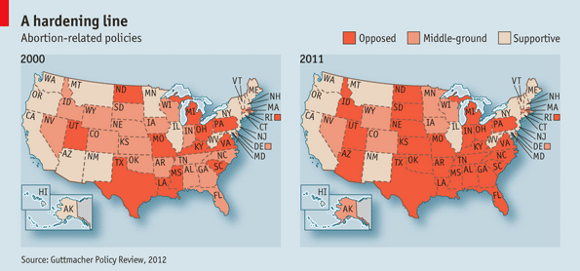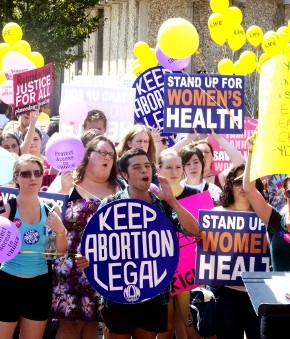by Dianne Feeley
March 21, 2014
This article appears in the March/April 2014 issue of Against the Current.
Three Years Ago, Tamesha Means was rushed to Mercy Health Partners Hospital in Muskegon, Michigan after her water broke 18 weeks into her pregnancy. The hospital diagnosed a premature rupture of membranes but sent her home, saying there was nothing to be done at that stage.

Tamesha Means.
The next day she returned with painful contractions, bleeding and elevated temperature. She was given two Tylenols and, after her temperature went down, sent home. Later that night, in excruciating pain, she returned for the third time. Once again she was told nothing could be done.
As staff prepared the papers for her discharge, she began to deliver. Only then did they deal with her miscarriage. She gave birth to a premature son, who died shortly afterward. Her medical records show that once her water broke the previous day, infection had sent in.
As a Catholic hospital, Mercy Health Partners adheres to the “Ethical and Religious Directives for Catholic Health Care Services.” Under that U.S. Conference of Catholic Bishop’s directive, “Abortion…is never permitted. Every procedure whose sole immediate effect is the termination of pregnancy before viability is an abortion.”
Means was never informed of any option: “They didn’t tell me what was happening to my body. Whatever was going on with me, they discussed it amongst themselves. I was just left to wonder, ‘What’s going to happen to me?’” Yet this is a teaching hospital, the second largest health care organization in western Michigan, and the only hospital in the county. How can religious directives dictate medical care?
One out of every nine U.S. hospital beds is in a Catholic hospital, governed by a document that guides various medical practices, including reproductive health issues. Some of its dictates contravene standard practice. For example, although the Center for Disease Control and Prevention reports that 88% of all women of reproductive age use some form of contraception, the U.S. Conference of Catholic Bishop’s 43-page guide requires hospital personnel to remain silent regarding contraception information.
Tamesha Means survived to initiate a suit with the aid of the American Civil Liberties Union in federal court against the U.S. Conference of Bishops for a policy directive that denied her emergency medical care. But Means is certainly not the only woman in America kept in the dark about the need to terminate her pregnancy.
Given that between 10-20% of all diagnosed pregnancies end in miscarriages, the unwillingness of Catholic hospitals to take appropriate and immediate steps to end a pregnancy endangers women’s lives. Women may face loss of blood, infection, the end to fertility or even death.
Of the seven million U.S. women who become pregnant each year, one million will have an abortion. About 70% will pay for their abortion out of pocket. The procedure costs somewhere between $300-$1700, depending on how early it is performed. (Throughout the country there are formal and informal networks of women who contribute to funding poor women’s abortions.)
How do the number of abortions today compare to the past? Before abortion was legalized in 1973, it was estimated that there were between 200,000 and 1.2 million procedures each year. Abortions peaked in 1996 at 1.6 million and have declined ever since. The percentage of pregnancies that end in abortion has also dropped, from a high of 30% in 1979-86 to half that today.
Yet more than 40 years after abortion in the United States became legal, both federal and state legislation limit women’s access. And women with the fewest resources have the least access. Certainly the 1976 passage of the federal Hyde Amendment, which denies women on Medicaid abortion except in cases in rape, incest or a life-threatening condition, made that clear.

This article focuses on the continuing assault on reproductive justice in 2013, particularly at the hands of state legislators. Twenty-two states passed 70 new restrictions, adding to the more than 135 passed in 2011 and 2012. (See “Reproductive Justice Needed!” ATC 163, March/April 2013.) Dominant were restrictions on providers, bans on abortion after 20-22 weeks of pregnancy and outlawing contraception or abortion coverage in various insurance plans.
Fights Under “Obamacare”
One positive regulation which emerged over the last few years is the federal Affordable Care Act’s mandate that private health insurers provide contraceptive coverage at no out-of-pocket expense. Religious nonprofits had objected to this provision and were granted an exception. Nonetheless The Little Sisters of the Poor, Catholic nuns, requested an emergency stay of its implementation; U.S. Supreme Court Justice Sonia Sotomayor issued a temporary stay at the end of 2013. In fact the nuns would only have to request an exemption, but they object to doing even that.
Additionally several employers demanded the same exception, citing personal objections. By the fall of 2013 eighteen for-profit companies had filed petitions for waivers in federal court, including Domino Farms, whose CEO, the ultraconservative Catholic ideologue Tom Monaghan, has described all contraceptives as “gravely immoral.”
At the end of November the U.S. Supreme Court agreed to hear two cases: Sebelius v. Hobby Lobby Stores and Conestoga Wood Specialties v. Sebelius. Both claim they are willing to offer insurance plans that cover some types of contraceptives, but not what they consider “abortifacients.” Conestoga objects to offering emergency contraceptives, while Hobby Lobby also objects to the use of intrauterine devices.
Despite this one regulation, and more talk of funding day care, the assault on women’s access to a range of reproductive rights continues. Twenty-three states have banned insurance coverage for most abortion services under an opt-out provision of the ACA. They claim this is needed since the basic health plans sold on the health care exchanges will be subsidized by taxes.
In December 2013 the Michigan legislature went further, passing an initiative submitted by Right to Life of Michigan that requires women who want abortion coverage under their insurance policy to purchase it as a rider to their regular policy. The Michigan law contains no exceptions and will go into effect in March 2014.
The National Women’s Law Center, which advocates for women, researched how many people bought riders in those states where the law was already in effect, and came up empty handed. “There are no statistics because they don’t exist,” reported Gretchen Borchelt, the center’s state reproductive health policies director. Even North Dakota, which has had such a law since 1979, could not point to any abortion rider.
New Restrictive Legislation

Photo by Amber-Lynn Taber.
Twenty-seven states have at least four different restrictions on abortion. These govern the majority of all U.S. women. Historically hospitals have been reluctant to provide abortion facilities, so clinics have taken up that task. However the current assault against women saddles them with unnecessary regulations.
Fewer than 0.3% of all abortions require hospitalization, so the idea that clinics should meet the same standards isn’t logical. Yet 13 states now demand that clinics have hospital-sized rooms and corridors. Virginia’s law prescribes the number of covered entrances and parking lots. Fourteen require affiliation with a local hospital, although Ohio, which previously had that law, reversed itself and now forbids such a relationship. Eight states, including Alabama, Indiana, North Carolina, North Dakota, Ohio, Texas, Virginia and Wisconsin passed clinic regulations in 2013.
While ultrasounds are not medically necessary for first-trimester abortions, several states have passed legislation requiring the procedure for all abortions. Early in the woman’s pregnancy the ultrasound probe must be administered vaginally — a procedure that meets the legal definition of rape. Such an unncessary and humiliating requirement is an attempt to sway the woman into continuing her pregnancy. Last year Indiana and Wisconsin passed this law, bringing the number of states requiring ultrasounds to 10.
Since the 1980s some states and the Veterans’ Administration have used long-distance medical conferencing in rural areas. Five years ago Planned Parenthood began using this method for the “morning after” pill, which has a 92-95% success rate if taken as directed within the first two months of pregnancy.
A woman seeking an early abortion could come to a clinic where a nurse would take her information, which would be passed on to a doctor. With the nurse present, the doctor would teleconference with the patient. At the end of the process the doctor would press a button to open a drawer where there were two medications. The woman would then take the first and use the second two days later, as directed. Returning to the clinic two weeks later, she would have a follow-up appointment. In case of a problem, she was to report directly to a hospital.
Although telemedicine had never before been challenged by a state legislature, the idea that rural women would have access to abortion rubbed legislators the wrong way. In 2012 Michigan outlawed teleconferencing for abortions — a serious attack in a state where 22 out of 83 counties have no practicing OB/GYN. Alabama, Indiana, Iowa, Louisiana, Mississippi, Missouri, North Carolina, Texas and Wisconsin banned teleconferencing for this procedure the following year.
Unsuccessful at stripping Planned Parenthood of funding at the federal level, the right has also been successful in getting 10 states to restrict or ban clinics that offer abortion counseling or abortions.
Along with passing these restrictions, the right wing is now directly challenging the flawed Roe v. Wade decision. The January 1973 U.S. Supreme Court ruling overturned laws outlawing abortion and established a trimester approach. During the first trimester, the court ruled, a woman and her doctor were in the driver’s seat. But during the second and third stage the state assumed more control, particularly so after fetal viability in the final trimester.
However, even in the third trimester, laws were to function to preserve the life and health of the woman and empower her physician to make medical decisions without other physicians having to confirm them.
Much subsequent legislation simply disregards these criteria. In fact, that decision has already been weakened by the 1992 U.S. Supreme Court decision, Planned Parenthood v. Casey, where “undue” restrictions were permitted. These included parental consent, 24-hour waiting periods between consultation and the procedure, and mandating counseling. Twenty-six states have enacted a waiting period, 39 have parental consent laws and 17 mandate counseling that functions to scare women by providing misinformation: five states require that the woman be told abortion leads to elevated rates of breast cancer, eight maintain there may be mental consequences, 12 insist that, if aborted, the fetus suffers pain.
All these restrictions fall more heavily on poorer women. They also perpetuate violence: women are ordered to follow rules about what they can and cannot do. They reinforce the power a partner might be able to exert over the woman, forcing her to stop taking the contraceptives she needs to control her fertility, forcing her to bear children she can’t nurture, forcing her to remain in a relationship that destroys her self-confidence.
Death by A Thousand Cuts
Those who oppose abortion understand that most people believe that women must have a degree of autonomy over our own bodies. There is majority support for contraception and abortion being legal and available. Instead of a frontal assault against all abortion, the right wing attempts to carve out space where people are invited to judge the pregnant woman, and decide whether her reason is “good enough.”
Through this method they seek to roll back a medical procedure by a thousand cuts. The right has been most successful in three areas: reducing abortion and contraceptive access to women on Medicaid, limiting access to young women through the passage of parental consent laws, and failing women who do not live in urban centers.

Todd Akin.
The most rabid rightwingers now dare to question whether women who have been raped were really raped. In the summer of 2012 Todd Akin, then Republican candidate for the U.S. Senate from Missouri, answering a question in a TV interview about allowing abortions in the case of rape, stated that “If it’s a legitimate rape, the female body has ways to try to shut that whole thing down.” A firestorm broke out over this ridiculous remark. But the remark represents the far side of what the right is attempting to do in their demand that laws judge women who dare to seek abortion.
Over the course of the years since the Roe v. Wade decision, state legislatures have proved helpful to the right, and have seen themselves amply rewarded. Especially since the rise of the Tea Party, many politicians have followed their instinct for self-preservation by escalating the attack on reproductive rights.
The right has also been successful in setting up a network of “alternative” clinics, usually called Crisis Pregnancy Centers. These are usually situated near to clinics that offer a range of reproductive services — but their alternative is to scare and dissuade a woman from seeking an abortion.
They have been most successful limiting late-term abortions. One might think, “Well that’s not so bad, after all 91% of all women obtaining abortion do so within the first 12 weeks of pregnancy, 99% before 21 weeks. Maybe if you are pregnant that long, you should just complete the pregnancy.” Of course, that erases the problems of incomplete miscarriages and fetal abnormalities — the reasons for most late abortions!
Fetal testing for major birth defects is performed around 18 weeks folowing the woman’s last menstruation. That’s when testing can reveal hydrocephalus (water on the brain), anencephaly (severe brain malformations), major heart defects, missing organs and limbs, etc. This represents about 2% of all pregnancies, with another half a percent having a chromosomal defect, such as an extra or missing DNA segment. These raise emotional and health issues women would want to examine.
Yet in these complicated situations, legislators dare to consider themselves better equipped to make decisions than the woman herself. This is codified in federal legislation the right has termed “partial birth abortion.” A law signed by president George W. Bush in 2003 outlaws certain medical procedures — maintaining that they are outside the law even when they might be the best option for the woman to end a late pregnancy. Nineteen states have similar laws.
In 2013 Arkansas, North Dakota and Texas joined Alabama, Arizona, Indiana, Kansas, Louisiana, Nebraska, North Carolina and Oklahoma in banning most abortion after 20-22 weeks. While the 1973 U.S. Supreme Court ruling allows some restrictions on second trimester abortion, clearly these are direct challenges to Roe.
Last year Colorado repealed its pre-Roe law in believing the time is right to challenge Roe v. Wade. Louisiana, Mississippi, North Dakota and South Dakota legislatures have announced that if Roe v. Wade were overturned, they would move to ban abortion outright. Eight others promise to restrict abortion to the maximum extent of the law.
Additionally 12 states have pre-Roe bans that remain on the books for resurrection (Alabama, Arizona, Arkansas, Delaware, Massachusetts, Michigan, Mississippi, New Mexico, Oklahoma, Vermont, West Virginia and Wisconsin) while only seven permit abortion before viability.
What Next?
In 1994 Congress passed and president Clinton signed into law the Freedom of Access to Clinic Entrances (FACE), which prohibits property damage, physical obstruction or threat of force against clinics.
This was passed after the firebombing and blockades of clinics and the murders of several physicians who performed abortions. (Dr. David Gunn had been killed just the previous year in front of a Florida clinic.) The law specifically exempts picketing, chanting and passing out leaflets in an attempt to draw a line between protest and harassment.
A few states subsequently passed legislation against blocking entrances or threatening and intimidating staff and patients. Half a dozen have “bubble zones” of a specific distance in order to protect patients from protestors. I expect the right will launch suits against these laws in the coming year (a Massachusetts law is now in the courts under a “free speech” challenge.)
After the passage of state laws that are clearly thumbing their noses at both the Affordable Care Act and Roe v. Wade, these will wind their way to the U.S. Supreme Court. Does this mean that the political elites have joined the right wing to drive women back into their homes, leaving us pregnant and barefoot?
I don’t believe that’s possible. It fits neither what late capitalism needs, nor what women will tolerate. But how far can the two cooperate? How much can the right to reproductive justice be gutted in practice?
From the point of view of women, the large majority of whom are working class, and our allies, the fight for reproductive rights seems more integral to the other political, economic and environmental issues than ever before.
Indeed, every mobilization in defense of reproductive justice is large and diverse. Despite decades of right-wing propaganda, the majority of people consistently support contraception, abortion and the right of women to make the decisions regarding our bodies. Whenever women tell our stories, the complexity of our lives and our struggle for justice is overwhelming.
However, the organizations that represent women, whether unions or nonprofits, remain in a defensive mode. They celebrate the defeat of each horrendous law — such as Albuquerque voters’ 2013 rejection of a referendum that would ban abortions after 20 weeks — but do not call for national mobilizations. If we compare the women’s rights campaigns with those of the LGBT community, we see how much further ahead the LGBT struggle has moved.
Capital needs to continue to repress working people, but doesn’t want to face a social explosion. I don’t predict the overturning of Roe v. Wade, but without a sustained counter offensive, there will be a continued assault that narrows the ground for reproductive justice.
The reality is that the women’s movement that fought for abortion rights did not demand a trimester approach, but an integrated view of our reproductive rights. It called for free, 24-hour quality childcare, for free abortion when needed, for an end to sterilization abuse and for the development of safe contraceptives.
Today that program needs refashioning to include a reduction in the work day, so that we can all participate in the raising of the next generation and caring for the older one — and to call for meaningful and environmentally appropriate work at a living wage.
Dianne Feeley is a retired autoworker in Detroit, and a member of Solidarity’s National Committee.
